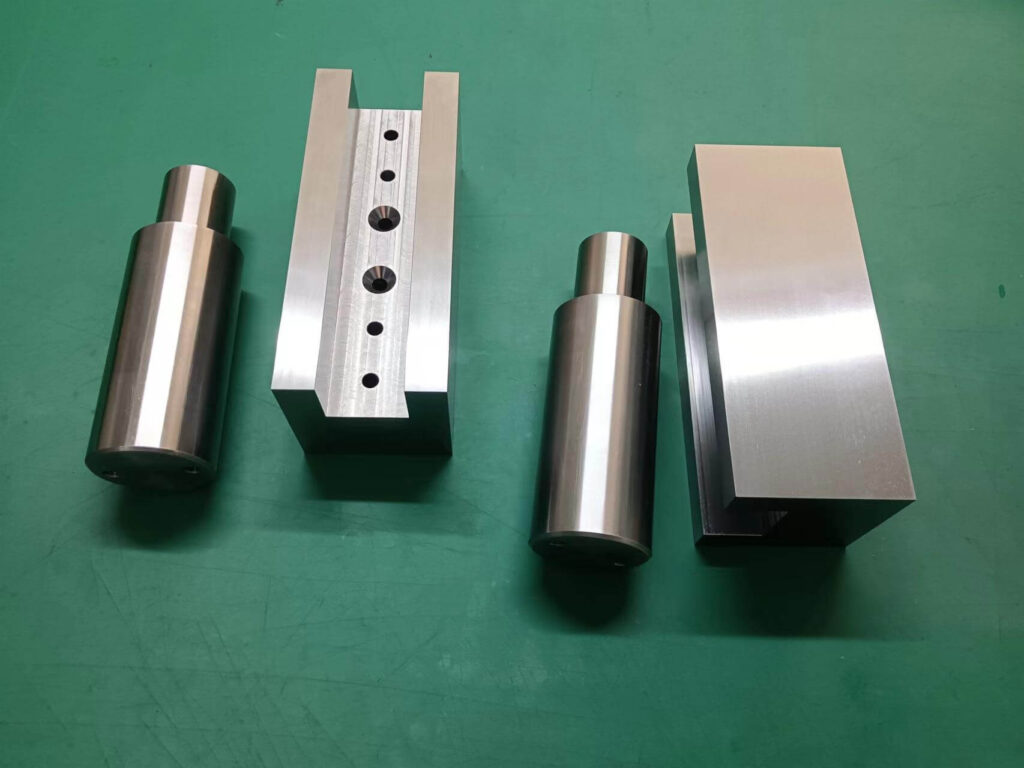Carbon steel is highly susceptible to rust and corrosion due to its high iron content and lack of naturally protective oxide layers found in other materials like stainless steel. Therefore, implementing anti-rust treatments during and after the machining process is crucial to ensure the longevity and performance of the machined parts.
Carbon Steel Types and Properties
1. Low Carbon Steel (Mild Steel)
Carbon Content: 0.05% – 0.25%
Key Properties:
- Soft, ductile, and easy to machine/weld
- Cannot be hardened effectively by heat treatment
- Often used in rolled forms (sheets, strips, bars)
Common Grades & Applications:
| Grade (AISI/SAE) | Carbon % | Key Applications |
| 1010 | 0.10% | Automotive panels, pipes, wire |
| 1018 | 0.18% | Shafts, machinery parts, bolts |
| 1020 | 0.20% | Structural steel, gears, fixtures |
| A36 (ASTM) | ≤0.29% | Construction beams, bridges, frames |
Note: Often galvanized or coated for corrosion resistance.
2. Medium Carbon Steel
Carbon Content: 0.25% – 0.60%
Key Properties:
- Stronger than mild steel but less ductile
- Can be heat-treated (quenching & tempering) for hardness
- Requires preheating for welding to avoid cracking
Common Grades & Applications:
| Grade (AISI/SAE) | Carbon % | Key Applications |
| 1040 | 0.40% | Gears, axles, crankshafts |
| 1050 | 0.50% | Springs, blades, high-strength parts |
| 4140 (Alloyed) | 0.40% + Cr/Mo | Aircraft parts, tooling, high-stress components |
| 4340 (Alloyed) | 0.40% + Ni/Cr/Mo | High-performance gears, military applications |
Note: Often used in normalized or tempered conditions for better toughness.
3. High Carbon Steel (Tool Steel)
Carbon Content: 0.60% – 1.0%
Key Properties:
- Very hard and wear-resistant but brittle
- Excellent for cutting tools and blades
- Poor weldability (requires special techniques)
Common Grades & Applications:
| Grade (AISI/SAE) | Carbon % | Key Applications |
| 1060 | 0.60% | Springs, high-strength wires |
| 1075 | 0.75% | Swords, knives, saw blades |
| 1095 | 0.95% | Premium knives, industrial blades |
| T1 (Tool Steel) | ~1.0% + W/V | Cutting tools, drill bits |
Note: Often heat-treated (hardened & tempered) for maximum edge retention.
4. Very High Carbon Steel (Specialty Steel)
Carbon Content: 1.0% – 2.0%
Key Properties:
- Extremely hard but brittle (prone to cracking)
- Limited industrial use; mostly for specialized tools
Common Grades & Applications:
| Grade (AISI/SAE) | Carbon % | Key Applications |
| 1080 | 0.80% | Industrial blades, springs |
| 1095+ | 0.95–1.03% | High-end knives, chisels |
| W1 (Water-Hardening Tool Steel) | ~1.0% | Files, punches, cutting dies |
Note: Rarely welded; used in small, high-wear components.
5.Free-Machining Steel (Low/Medium Carbon with Additives)
- Grades:12L14 (Lead-added), 11L17 (Sulfur-added)
- Uses:Fast machining parts (screws, bolts, fittings)
- Trade-off:Reduced ductility & weldability
- Comparison Table:
| Type | Carbon Content | Strength | Ductility | Weldability | Heat Treatable? |
| Low Carbon Steel | 0.05–0.25% | Low | High | Excellent | No |
| Medium Carbon | 0.25–0.60% | Medium | Medium | Moderate | Yes |
| High Carbon | 0.60–1.0% | High | Low | Poor | Yes |
| Very High Carbon | 1.0–2.0% | Very High | Very Low | Very Poor | Yes |

Anti-Rust Measures During Machining
- Use of Coolants with Anti-Corrosion Properties
- Select machining coolants or cutting fluids that include anti-corrosion additives to protect the material during processing.
- Regularly check and maintain coolant concentration levels to ensure effectiveness.
- Minimizing Exposure to Moisture
- Avoid prolonged exposure of carbon steel to high-humidity environments or water during machining.
- Use air blowers or drying equipment to remove moisture immediately after machining.
- Oil or Grease Application
- Apply a light layer of anti-rust oil or grease to machined surfaces immediately after processing to form a temporary protective barrier.
- Suitable for parts awaiting further treatment or assembly.
- Avoid Handling with Bare Hands
- Oils and moisture from human hands can accelerate rust formation.
- Use gloves or handling tools to prevent direct contact with machined parts.
Anti-Rust Treatments After Machining
- Protective Coatings
- Dip Oil: Submerge parts in anti-rust oil to provide a long-lasting protective layer. This method is cost-effective and widely used.
- Phosphate Coating: Apply a phosphate layer to improve corrosion resistance and serve as a primer for additional coatings or painting.
- Zinc Plating or Galvanizing: Add a zinc coating to protect carbon steel from environmental exposure, particularly in outdoor applications.
- Painting or Powder Coating
- Apply paint or powder coating to create a durable, rust-resistant finish. This is particularly effective for parts exposed to harsh environments.
- Sealing in VCI (Vapor Corrosion Inhibitor) Packaging
- Use VCI paper or bags to create a controlled environment that prevents rust formation during storage and transportation.
- Heat Treatment (Optional)
- Certain heat treatments, such as case hardening or nitriding, can enhance surface properties, including rust resistance, while improving part strength.
Long-Term Rust Prevention
- Regular Inspection
- Periodically inspect stored parts for signs of rust and reapply anti-rust coatings if necessary.
- Proper Storage Environment
- Store parts in a dry, low-humidity environment.
- Use climate-controlled storage facilities for long-term preservation.
- Desiccants and Moisture Absorbers
Place desiccants in the packaging to absorb residual moisture and maintain a dry environment.
key factors to consider for effective packing
When packing carbon steel machined parts, proper packaging is crucial to prevent corrosion, physical damage, and contamination during storage or transportation.
Rust Preventive Oils/Sprays – Light coating (e.g., WD-40, Cosmoline) for short-term protection.
VCI (Vapor Corrosion Inhibitor) Paper/Film – Wraps parts and releases anti-corrosion vapors.
Desiccant Packs – Absorbs moisture inside sealed packages.
Wax or Grease Coating – For long-term storage (heavy-duty protection).
Vacuum Sealing – For high-value precision parts (eliminates oxygen exposure).
Avoid:
- Bare metal contact with cardboard(acidic, can promote rust).
- Packing in humid environments without protection.
Conclusion
By incorporating anti-rust treatments into every stage of the machining process, SYM Precision Machining ensures that carbon steel machined parts remain in optimal condition during production, storage, and transportation. These measures not only preserve the integrity and functionality of the parts but also demonstrate our commitment to delivering high-quality, reliable components to our customers.



